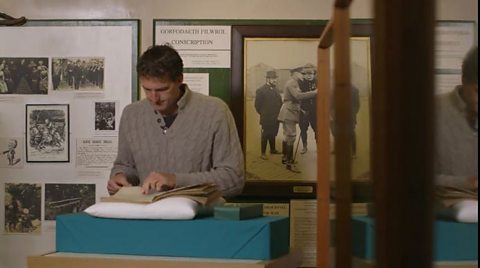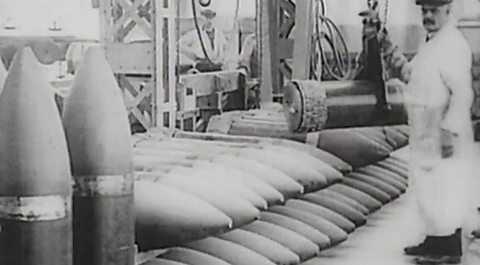DAN SNOW:Hello, I'm Dan Snow. Now anyone looking at World War One knows that 1918 is the year the conflict ended after four years of bitter fighting.
DAN SNOW:But 1918 is also the year in which Britain's Royal Airforce officially came into being, joining the army and the Royal Navy to complete our armed forces.
But the RAF wasnβt suddenly conjured up in 1918 out of nothing, before it, there was the Royal Flying Corps and to find out how that operation started, here's Joe Crowley with a report that he made to mark the Corps' 100th anniversary, back in 2012.
DOUG GREGORY:Righty-ho.
JOE CROWLEY:Now for anyone with even the slightest sense of history, this is an awesome sight. That gent there is 89-year-old Doug Gregory. He's a World War Two pilot and he's doing his prefight checks on his SE5A, an aircraft designed during the First World War.
JOE CROWLEY:'Today his plane is taking off from Old Sarum Airfield near Salisbury 'and flying around eight miles North West to a special place 'called Larkhill, to salute the centenary of the Royal Flying Corps - 'our first air force.
JOE CROWLEY:'Amateur aircraft enthusiasts began flying at Larkhill in 1909 'and it rapidly became a centre for the development of aviation.'
TED MUSTARD:Well we're surrounded by what was then War Office land, but it had been made available to the early aeronauts to use for their experimentation, 'and then on the back of that agreement, 'an aviation pioneer called Horatio Barber 'built a hanger to set up a small aviation company.'
JOE CROWLEY:In those days no trees, no buildings, so nobody to complain about the noise.
JOE CROWLEY:'Here in Britain, the government was slow to see 'how these new-fangled flying machines can be of benefit.'
SUSAN LINDSAY:In 1909, the War Office issued an announcement in which they said that they really werenβt prepared to invest any more money in experiments with aeroplanes because they considered it an useless and expensive fad.
SUSAN LINDSAY:And about the time the British had made that decision, Germany had invested about Β£400,000 in aeroplane research alone. So clearly they could see it had a future.
JOE CROWLEY:'But the enthusiastic lobbying of amateur pilots based at Larkhill 'and their pioneering work helped to move military aviation forward.
JOE CROWLEY:'So when the Royal Flying Corps was founded in 1912, 'this was an obvious location for the first squadron 'with military aeroplanes.'
JOE CROWLEY:But initially the lack of both machines and men was a problem, not helped by the fact the first recruits had to pay for their own flying lessons.They did get a refund but only once they'd joined up.
JOE CROWLEY:'The Royal Flying Core had an army wing and a naval wing 'which later split apart. 'But both had a hotchpotch of second-hand planes, 'mostly French built. 'What we needed was a good British aircraft.
JOE CROWLEY:'So one of the first events of Larkhill was a competition 'to find an outstanding machine for the Corps to fly.'
TED MUSTARD:Anybody in Europe who was interested in Aviation would have wanted to be here, and in fact most of them were. All the famous French, Italian pilots were here. And also they the public, who were allowed to come as well.
TED MUSTARD:The man who won it was Samuel F. Cody and he produced a very impractical aircraft but with a massive engine, so he could really outperform anybody else in just about all sections of the competition.
TED MUSTARD:He met all the criteria, but the aircraft was made of bamboo and fabric. Although he won, it really wasnβt a very practical aeroplane.
'Cody's winning machine never actually made it into service, 'but when The First World War broke out, 'British aircraft developed rapidly.
JOE CROWLEY:'One of the most successful was the SE5A, 'a much stronger and more stable biplane.
JOE CROWLEY:'This one is a fully accurate replica, 'built and flown by the WWII pilot, Doug Gregory.' Doug you fought in the Second World War as a pilot, you've got an incredible amount of experience.
JOE CROWLEY:What do you make of those early pioneers and those World War One pilots?
DOUG GREGORY:Oh, take me hat off to them. Wonderful bunch. Going off into, virtually unknown. Generally wondering if the jolly thing is going to stay together. And I think these chaps⦠keen to find out, keen to explore. Wonderful, wish I met some of them.
JOE CROWLEY:The Royal Flying Corps was our first air service, but it lasted just six years. Then on the 1st of April 1918, a single service was formed, reuniting the naval and army wings to create the Royal Air Force.
JOE CROWLEY:'Where the Royal Flying Corps began with so little, 'by the end of the First World War, the RAF was the most powerful 'air force in the world. 'With more than 20,000 aircraft and nearly 300,000 personnel.
JOE CROWLEY:'Larkhill here on Salisbury plane, is where it all began 100 years ago.'
Video summary
The Royal Flying Corps was established in 1912.
Joe Crowley looks at how the Corps needed amateur pilots to persuade the government of its value, with the first squadron set up at Lark Hill.
Recruits had to pay for their own flying lessons to begin with and had a mix of second hand planes to fly.
The First World War saw advancement in by-plane technology built with sturdier materials.
On April 1st 1918 the Royal Airforce was founded, combining the naval and army wings.
By the end of the First World War, the RAF had over 20,000 aircraft.
Teacher Notes
Key Stage 3:
Students could be asked to list the challenges they think there would be in setting up an air force as part of the armed forces.
For example, whether it should be a stand-alone force or part of the army or navy.
They could then watch the clip and see if their opinions have changed or if they can add any more ideas to their list.
The clip could also be used to compare the air force at the end of World War One with the RAF today- to find similarities and differences.
Key Stage 4 / GCSE / Higher Levels:
Could be used as part of a lesson about new technology and warfare in World War One.
Students could be asked to list all the uses of aeroplanes shown on the clip and then explain how these uses might help in the war overall, such as how aeroplane technology could be used to support soldiers in the trenches.
They could compare the use of aeroplanes to other new technology such as artillery, machine guns and gas to evaluate which had the biggest impact on the war.
This clip will be relevant for teaching History at KS3 and KS4/GCSE in England Wales and Northern Ireland.
Also at 3rd Level, 4th Level, National 4/National 5 and Higher in Scotland.
How challenging was the life of a pilot in World War One? video
James May looks at the dangers and challenges facing pilots in World War One.

What was agreed at the Treaty of Versailles? video
Dan Snow looks at the terms and consequences of the Treaty of Versailles.

How did Britain meet demands for weapon production in World War One? video
Saul David on how Britain struggled to produce the weapons to supply the army in World War One.
